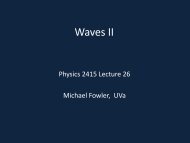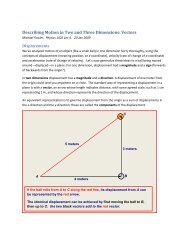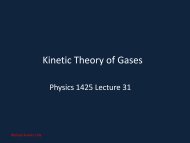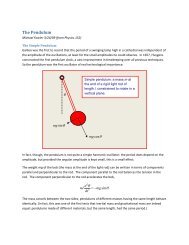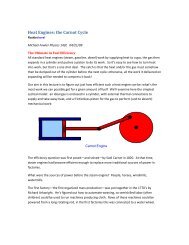Thermal Expansion Coefficients - Galileo and Einstein
Thermal Expansion Coefficients - Galileo and Einstein
Thermal Expansion Coefficients - Galileo and Einstein
- No tags were found...
Create successful ePaper yourself
Turn your PDF publications into a flip-book with our unique Google optimized e-Paper software.
1<strong>Thermal</strong> <strong>Expansion</strong> <strong>Coefficients</strong>Michael Fowler: this material is from my Physics 152 Notes. 7 April 2009IntroductionAlmost all materials exp<strong>and</strong> on heating—the most famous exception being water, which contracts as itis warmed from 0 degrees Celsius to 4 degrees. This is actually a good thing, because as freezingweather sets in, the coldest water, which is about to freeze, is less dense than slightly warmer water, sorises to the top of a lake <strong>and</strong> the ice begins to form there. For almost all other liquids, solidification oncooling begins at the bottom of the container. So, since water behaves in this weird way, ice skating ispossible! Also, as a matter of fact, life in lakes is possible—the ice layer that forms insulates the rest ofthe lake water from very cold air, so fish can make it through the winter.Linear <strong>Expansion</strong>The coefficient of linear expansion of a given material, for example a bar of copper, at a giventemperature is defined as the fractional increase in length that takes place on heating through onedegree:0 L L L 1 L when T T 1 COf course, might vary with temperature (it does for water, as we just mentioned) but in fact for mostmaterials it stays close to constant over wide temperature ranges.6For copper, 1710 .Volume <strong>Expansion</strong>For liquids <strong>and</strong> gases, the natural measure of expansion is the coefficient of volume expansion, .0 V V V 1 V when T T 1 COf course, on heating a bar of copper, clearly the volume as well as the length increases—the barexp<strong>and</strong>s by an equal fraction in all directions (this could be experimentally verified, or you could justimagine a cube of copper, in which case all directions look the same).The volume of a cube of copper of side L is V = L 3 . Suppose we heat it through one degree. Puttingtogether the definitions of , above,3 3 3 3V 1 V , L 1 L, L 1 L or V 1 V.
2So 1 1 3 . But remember is very, very small—so even though 3 2 31 1 3 3 , the last two terms are completely negligible (check it out!) so to afantastically good approximation: 3 .The coefficient of volume expansion is just three times the coefficient of linear expansion.<strong>Thermal</strong> Properties of GasesIntroduction: First, Boyle’s LawEveryone knows that although water (like other liquids) is pretty much incompressible, air iscompressible—you can squeeze a small balloon to a noticeably smaller volume with your h<strong>and</strong>s, <strong>and</strong>you can push in a bicycle pump to some extent even if you block the end so no air escapes. Boyle wasthe first person to make a quantitative measurement of how the volume of a fixed amount of air wentdown as the pressure increased.MoveablepistonGasOne might imagine doing the experiment with gas in a cylinder as in the diagram here, putting ondifferent weights <strong>and</strong> measuring the volume of the gas. Once the piston is at rest, the pressure of thegas multiplied by the area of the piston would just balance the weight of the piston plus the addedweight, so the pressure is easy to find.But there is one tricky point here: if the gas is compressed fairly rapidly—such as by adding a substantialweight, so the piston goes down suddenly—the gas heats up. Then, as the heat escapes graduallythrough the walls of the cylinder, the gas gradually settles into an even smaller volume.
3Boyle’s ExperimentBoyle worked with a small amount of air trapped in a closed arm of a U-tube, varying the pressure byadding mercury to the other arm, <strong>and</strong> waiting for the volume of the air to become constant as itstemperature adjusted.AtmosphericpressureMercury addedAir trapped insealed endAtmosphericpressureTrapped airvolume down byfactor of 20.76m = 29in. ofMercury = 1 atm.MercuryBoyle found that when more mercury was poured into the tube, increasingpressure on the trapped air, the air volume halved if the total pressure, includingthat from the atmosphere, was doubled.By repeating the experiment with varying amounts of mercury in the tube, meaning varying pressures,he was able to establish that once the trapped air had settled to room temperature, its volume wasinversely proportional to the applied pressure (including of course the always present atmosphericpressure).That is, at constant temperature,PV = constant.
4Gas Pressure Increase with TemperatureIn 1702, Amontons discovered a linear increase of P with T for air, <strong>and</strong> found P to increase about 33%from the freezing point of water to the boiling point of water.That is to say, he discovered that if a container of air were to be sealed at 0C, at ordinary atmosphericpressure of 15 pounds per square inch, <strong>and</strong> then heated to 100C but kept at the same volume, the airwould now exert a pressure of about 20 pounds per square inch on the sides of the container. (Ofcourse, strictly speaking, the container will also have increased in size, that would lower the effect—butit’s a tiny correction, about ½% for copper, even less for steel <strong>and</strong> glass.)Remarkably, Amontons discovered, if the gas were initially at a pressure of thirty pounds per square inchat 0C, on heating to 100C the pressure would go to about 40 pounds per square inch—so thepercentage increase in pressure was the same for any initial pressure: on heating through 100C, thepressure would always increase by about 33%.A century later, Gay Lussac did careful experiments <strong>and</strong> found the same linear relationship was true formany different gases. He also (ironically, since he didn’t believe in it: Knowles Middleton, page 111)made a fairly accurate estimate of absolute zero, in that he said the expansion of a gas between 0C <strong>and</strong>100C was 100/26666 per degree, suggesting absolute zero at -267C, off by about 2%.Finding a Natural Temperature ScaleActually you do this in the lab accompanying this course: plotting air pressure as a function oftemperature for a fixed volume of air, making several measurements as the air is slowly heated (to giveit a chance to all be at the same temperature at each stage), <strong>and</strong> you find a straight line. On the graph,extending the line backwards leads to the remarkable prediction that the pressure should drop to zeroat a temperature of about 273C.In fact, air doesn’t actually follow the line all the way down, but condenses to a liquid at around 200C.However, helium gas stays a gas almost to 270C, <strong>and</strong> follows the line closely.We shall discuss the physics of gases, <strong>and</strong> the interpretation of this, much more fully in a couple oflectures. For now, the important point is that this suggests a much more natural temperature scale thanthe Celsius one: we should take 273C as the zero of temperature! For one thing, if we do that, thepressure/temperature relationship for a gas becomes beautifully simple:PT.This temperature scale, in which the degrees have the same size as in Celsius, is called the Kelvin orabsolute scale. Temperatures are written 300K. To get from Celsius to Kelvin, just add 273 (strictlyspeaking, 273.15).
5An Ideal GasPhysicists at this point introduce the concept of an “Ideal Gas”. This is like the idea of a frictionlesssurface: it doesn’t exist in nature, but it is a very h<strong>and</strong>y approximation to some real systems, <strong>and</strong> makesproblems much easier to h<strong>and</strong>le mathematically. The ideal gas is one for which P T for alltemperatures, so helium is close to ideal over a very wide range, <strong>and</strong> air is close to ideal at ordinaryatmospheric temperatures <strong>and</strong> above.The Gas LawWe say earlier in the course that for a gas at constant temperature PV = constant (Boyle’s Law). Nowat constant volume, P T .We can put these together in one equation to find a relationship between pressure, volume <strong>and</strong>temperature:PV = CTwhere C is a constant. Notice, by the way, that we can immediately conclude that at fixed pressure,V T , this is called Charles’ Law. (Exercise: prove from this that the coefficient of volume expansion ofa gas varies significantly with temperature.)But what is C? Obviously, it depends on how much gas we have—double the amount of gas, keeping thepressure <strong>and</strong> temperature the same, <strong>and</strong> the volume will be doubled, so C will be doubled. But noticethat C will not depend on what gas we are talking about: if we have two separate one-liter containers,one filled with hydrogen, the other with oxygen, both at atmospheric pressure, <strong>and</strong> both at the sametemperature, then C will be the same for both of them.One might conclude from this that C should be defined for one liter of gas at a specified temperature<strong>and</strong> pressure, such as 0C <strong>and</strong> 1 atmosphere, <strong>and</strong> that could be a consistent scheme. It might seemmore natural, though, to specify a particular mass of gas, since then we wouldn’t have to specify aparticular temperature <strong>and</strong> pressure in the definition of C.But that idea brings up a further problem: one gram of oxygen takes up a lot less room than one gram ofhydrogen. Since we’ve just seen that choosing the same volume for the two gases gives the sameconstant C for the two gases, evidently taking the same mass of the two gases will give different C’s.Avogadro’s HypothesisThe resolution to this difficulty is based on a remarkable discovery the chemists made two hundredyears or so ago: they found that one liter of nitrogen could react with exactly one liter of oxygen toproduce exactly two liters of NO, nitrous oxide, all volume measurements being at the sametemperature <strong>and</strong> pressure. Further, one liter of oxygen combined with two liters of hydrogen toproduce two liters of steam.
6These simple ratios of interacting gases could be understood if one imagined the atoms combining toform molecules, <strong>and</strong> made the further assumption, known as Avogadro’s Hypothesis (1811):Equal volumes of gases at the same temperature <strong>and</strong> pressure containthe same number of molecules.One could then underst<strong>and</strong> the simple volume results by assuming the gases were made of diatomicmolecules, H 2 , N 2 , O 2 <strong>and</strong> the chemical reactions were just molecular recombinations given by theequations N 2 + O 2 = 2NO, 2H 2 + O 2 = 2H 2 O, etc.Of course, in 1811 Avogadro didn’t have the slightest idea what this number of molecules was for, say,one liter, <strong>and</strong> nobody else did either, for another fifty years. So no-one knew what an atom or moleculeweighed, but assuming that chemical reactions were atoms combining into molecules, or rearrangingfrom one molecular pairing or grouping to another, they could figure out the relative weights of atoms,such as an oxygen atom had mass 16 times that of a hydrogen atom—even though they had no ideahow big these masses were!This observation led to defining the natural mass of a gas for setting the value of the constant C in thegas law to be a “mole” of gas: hydrogen was known to be H 2 molecules, so a mole of hydrogen was 2grams, oxygen was O 2 , so a mole of oxygen was 32 grams, <strong>and</strong> so on.With this definition, a mole of oxygen contains the same number of molecules as a mole of hydrogen: soat the same temperature <strong>and</strong> pressure, they will occupy the same volume. At 0C, <strong>and</strong> atmosphericpressure, the volume is 22.4 liters.So, for one mole of a gas (for example, two grams of hydrogen), we set the constant C equal to R,known as the universal gas constant, that is PV = RT withR = 8.3 J/(mol.K) .For n moles of a gas, such as 2n grams of hydrogen, the law is:<strong>and</strong> this is the st<strong>and</strong>ard form of the Gas Law.PV = nRTWe now know, of course, that Avogadro’s number is 6.02×10 23 molecules per mole.(Footnote: after the discovery of isotopes, nuclei of the same element having different masses, <strong>and</strong> inparticular of a form of hydrogen called heavy hydrogen present in small quantities in nature, thedefinition of the mole was refined to be equal to precisely 12 grams of the carbon isotope C 12 . Inpractice, this is a tiny correction which doesn’t affect anything we’ve said here.)





